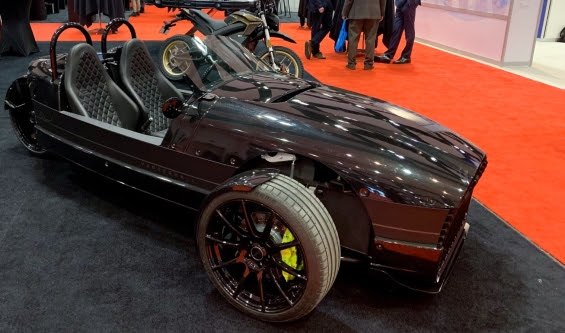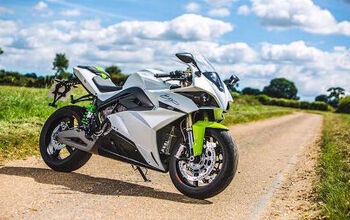How to Juice the Electric Motorcycle Market
For starters, Zero is branching out by sharing its electric powertrain with vehicles packing more than two wheels. At this year’s IDTechEx Show! in Santa Clara, California, Zero showed off an electric Vanderhall (lead photo), along with a four-wheeled electric go-kart, both using its powertrain. According to an IDTechEx Research report, that’s a good idea given that the motorcycle market is the western world has been stagnant for the last decade. Italy’s Energica seconds that emotion, but adds that while the western motorcycle industry may be stagnant, electric motorcycle sales are growing in the rest of the world: Tapping into markets in Asia and supplying quality powertrains for other light electric vehicles will be important paths to growth going forward. The rest of the report follows.
Electric motorcycles: the search for new markets
Thursday, 20 December 2018
IDTechEx
Cambridge, UK
Zero Motorcycles have exhibited at the past two IDTechEx events, and typically showcase their sporty S and off-road DS models, as well as their impressive 45kW electric motors (designed from scratch in California and produced at a factory in China). This year, at the IDTechEx Show! in Santa Clara California, things were markedly different. Zero staged two more light electric vehicles: a three-wheeled electric Vanderhall, and a four-wheeled electric go-kart, both using its powertrain. While these are still niche categories (in fact, the gasoline version of the Vanderhall has only been available to buy for the past couple of years), it is a statement from the company that it does not want to be thought of as purely a motorcycle brand. As found in the IDTechEx Research report Electric Two-wheelers 2019 – 2029, it reflects a stagnating motorcycle industry, which has been unable to attract a new younger audience for the past decade.
The gasoline version of the Vanderhall ‘Venice’, the cheapest model, is on sale for just under $30,000 — cheaper than a Harley Davidson touring bike. The electric version would be slightly more expensive, but much cheaper to run.
The electric Vanderhall at the IDTechEx Show! in Santa Clara. Source: IDTechExA go-kart with Zero Motorcycles’ powertrain. Source: IDTechExEnergica, an electric superbike maker based in Italy, echoed Zero Motorcycles’ troubles during its conference presentation, showing motorcycle sales data that has flatlined since the economic crisis (see below). Part of issue is down to safety conscious millennials: 5.4 percent of Baby Boomers owned a motorcycle versus 1.6 percent of Millennials, according to presented data. Another issue is the perceived image: ‘In the U.S. motorcycles are not a mode of transportation — they are above all a personal expression’ said Mr Stefano Benatti, CEO. The result: it is harder for electric two-wheelers to break from the image of ‘a dowdy commuter vehicle for environmental fanatics’ which auto startups like Tesla have done so well. However, while the western motorcycle industry as a whole is stagnant, electric motorcycle sales are growing: they are not necessarily viewed as ‘dowdy’ once ridden. Increasing sales further will require fresh strategies like tapping into markets in Asia, or supplying quality powertrains for other light electric vehicles.
Data provided on the IDTechEx Portal. Source: Energica via the Motorcycle Industry Council report 2017A cautionary tale in the industry has been the story of Alta Motors: an electric motocross bike start-up once based in California. Alta’s strategy was also to look beyond the premium motorcycle segment — it intended to produce low-power e-scooters in high volume, tapping into markets in Asia (India for example sells roughly 20 million motorcycles per year, most < 200cc). However, before things could really take off the company ran out of cash, and production ceased in October 2018. Zero’s strategy is more cautious: trying toopen up new markets by becoming a powertrain supplier, without making something new, may be a winning strategy.
Learn more in the IDTechEx report Electric Two-Wheelers 2019 – 2029. Based on a global assessment IDTechEx Research has developed forecasts by category and region for 2019 – 2029.
The key takeaways / benefits of the research in this report are:
• Analysis of where e-bikes, e-scooters and e-motorcycles will be dominant and why, including historical data.
• Current year market size and forecasts up to 2029 by power class / speed: e-bikes 25kmph, e-motorcycles > 4kW.
• Current year market size and forecasts up to 2029 by region, including India, Indonesia, Vietnam, Taiwan, Thailand, China, U.S. and Europe.
• Comparison of different electric two-wheeler models – technologies, costs, players and government support.
• Market share of leading e-motorcycle manufacturers and comprehensive list and specification of current models.
• Report from visit to Zero Motorcycles manufacturing facility in California, and company profiles based on IDTechEx interviews.
For more information contact research@IDTechEx.com or see www.IDTechEx.com/evtwowheel.
More by John Burns




























Comments
Join the conversation
I have a great deal of respect and admiration for Zero Motorcycles (the company and the bikes). I was not impressed with their early bikes, but they are now building real motorcycles.
In 2017, they were offering test rides at a car show I went to, and let me ride a DSR. In eco-mode, it was a very mild, pleasant ride. In sport-mode, it almost ripped my arms out of their sockets at street speeds (30-45 mph). It was a wild experience. The noise and vibration levels felt like you were idling around in 6th, but the throttle response was like being in 1st or 2nd.
There wasn't time to play around with the custom settings, but being able to customize the response would be great. After the 10-15 mile test ride, I was very impressed. Brakes, handling, suspension, motor, lack of noise & vibration, etc. Again, it was a real motorcycle, both very familiar and very different.
The sales/marketing people were friendly and informed, but not pushy. It was a fun time. I like the reduced maintenance costs. I like the fact that they are selling motorcycles, rather than virtue signalling. The "environmentally friendly" part of the website is tasteful and appropriate.
There are still a few downsides. Having too many motorcycles and not enough money, I wasn't in the market. The purchase price is still high, and the range is still limited. If I had more money and fewer motorcycles, I would seriously consider getting a Zero SR.
Powered by Zero. I can see it. The differences between the failed companies and Zero is fairly simple. Zero is in year 12. They have weather many growing pains. They have a dealer network. The current manufacturing partners must now catch up to them in many categories of development, network and business modeling. If they succeed then Zero can do what others will ultimately mimic. What truly surprises me is the fact that someone with very deep pockets hasn't made an offer for the company that the Zero execs just couldn't turn down.